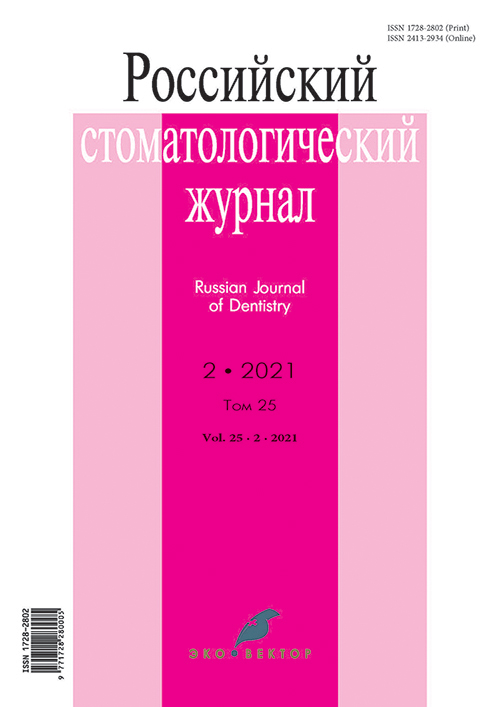Diseases of the musculoskeletal complex of the temporomandibular joint: the frequency of occurrence, clinical features, etiopathogenic factors
- Authors: Redinova T.L.1, Redinov I.S.1, Chikurova N.V.2
-
Affiliations:
- Izhevsk State Medical Academy
- Sarapul City Dental Clinic
- Issue: Vol 25, No 2 (2021)
- Pages: 185-192
- Section: Organization of Healthcare Service
- Submitted: 17.03.2022
- Accepted: 17.03.2022
- Published: 15.03.2021
- URL: https://rjdentistry.com/1728-2802/article/view/105064
- DOI: https://doi.org/10.17816/1728-2802-2021-25-2-185-192
- ID: 105064
Cite item
Abstract
BACKGROUND: The frequency of diseases of the temporomandibular joint (TMJ) is quite high, which requires the development of special arthrological care in various regions of Russia with the involvement of specialists in various fields.
AIM: Study the occurrence of diseases of the musculoskeletal complex among patients of dental admission who applied for oral cavity sanitation without acute pain, and to determine the significance of various etiological factors.
MATERIAL AND METHODS: It was examined by interviewing and dental examination of 100 patients of therapeutic reception aged from 20 to 60 years old. Based on dental complaints, three conditional groups were formed from the number of examined patients. The 1st group included 47 patients who had no complaints of discomfort and pain in the temporomandibular joint dysfunction area. The second group included 24 patients who complained of “clicks” in the temporomandibular joint dysfunction, sometimes difficulties and restrictions when opening the mouth. The third group consisted of 29 people who complained of pain in the TMJ, tinnitus, a sense of tension and pain in the muscles of the maxillofacial region.
RESULTS: The study showed that the number of people with signs of temporomandibular joint dysfunction diseases among dental patients is 53.0%. Moreover, the number of people with temporomandibular joint dysfunction pathology was statistically the same among the examined people of different ages. In individuals with signs of temporomandibular joint dysfunction diseases (2nd and 3d groups) and without them (first group), there were no differences in the number of individuals with occlusion disorders (abnormal bite, disocclusion, supercontacts, loss of occlusal contacts or restored by restoration with filling materials), however, in groups with signs of temporomandibular joint dysfunction diseases, a statistically significantly higher number of patients with musculoskeletal disorders was found, while every second of the examined patients experienced emotional tension and stress.
CONCLUSION: Due to the fact that patients with intra-articular disorders and pain syndrome of TMJ dysfunction are significantly more often identified diseases of the musculoskeletal system, the treatment of this category of patients requires consultation, and, if it’s necessary, treatment by an osteopath.
Full Text
About the authors
Tatyana L. Redinova
Izhevsk State Medical Academy
Email: tatiana.redinova@yandex.ru
ORCID iD: 0000-0002-8963-2025
MD, Dr. Sci. (Med.), Professor
Russian Federation, 281, Kommunarov str., Izhevsk, Udmurt Republic, 426034Ivan S. Redinov
Izhevsk State Medical Academy
Email: ivan.redinov@yandex.ru
ORCID iD: 0000-0002-5888-9725
MD, Dr. Sci. (Med.), Professor
Russian Federation, 281, Kommunarov str., Izhevsk, Udmurt Republic, 426034Natalia V. Chikurova
Sarapul City Dental Clinic
Author for correspondence.
Email: natachik_77@mail.ru
dentist-therapist
Russian Federation, SarapulReferences
- Timofeeva MI, Maltsev SN, Zubarev VA. Assessment of the functional state of the masticatory and temporal muscles in temporomandibular joint dysfunction. In: Essays on medical and social rehabilitation of children with health problems. Ed. by S.I. Blokhin. Ch. 2. Еkaterinburg; 1995. Р. 41–44. (In Russ).
- Dos Reis AC, Hotta TH, Ferreira-Jeronymo RR, et al. Ear symptomatology and occlusal factors: A clinical report. J Prosthet Dent. 2000;1(83):21–24. doi: 10.1016/s0022-3913(00)70084-9
- Benoliel R, Sharav Y. Accurate diagnosis of facial pain. Cephalalgia. 2006;26(7):902–903. doi: 10.1111/j.1468-2982.2006.01116_1.x
- Beinarovich SV. Features of the biomechanics of the lower jaw in patients with dysfunctional states of the temporomandibular joints and chewing muscles. Clinical Dentistry. 2017;2(82):50–51. (In Russ).
- Yatsuk AV, Sivolapov KA. Analysis of the incidence of the musculoskeletal complex of the temporomandibular joint in residents of the Kemerovo region. Institute of Dentistry. 2019;(2):16–17. (In Russ).
- Clinical protocol of medical care for diseases of the temporomandibular joint, approved at the meeting of the StAR Section "Association of Maxillofacial Surgeons and Dental Surgeons" on April 21, 2014, Moscow; 2014. 82 p. (In Russ).
- Oreshaka OV, Dementieva EA, Ganisik AV, Sharov AM. Epidemio- logy of diseases of the temporomandibular joint. Clinical dentistry. 2019;(4):97–99. (In Russ). doi: 10.37988/1811-153X_2019_4_97
- Redinova TL, Frolova VV, Korshunova OA, et al. Morbidity according to the appeal of the adult population of Izhevsk for dental care. Health, Demography, Ecology of the Finno-Ugric Peoples. 2017;(1):10–14. (In Russ).
- Lepilin AV, Konnov VV, Bagaryan EA. Clinical manifestations of pathology of the temporomandibular joints and masticatory muscles in patients with impaired occlusion of teeth and dentition. Saratov Scientific and Medical Journal. 2010;6(2):405–410. (In Russ).
- Bragin EA, Dolgalev AA, Bragareva NV. The role of occlusive disorders in the development of diseases of the temporomandibular joint, chewing muscle dysfunctions and periodontal diseases. Scientific Review. Medical Sciences. 2015;(1):90–91. (In Russ).
- Fadeev RA, Markasov KN, Emgakhov AV, Egorova DV. Study of the structure of the temporomandibular joint in patients with pathology of hard tissues of teeth of non-carious origin. Institute of Dentistry. 2015;(4):70–73. (In Russ).
- Manfredini D, Winocur E, Guarda-Nardini L. Epidemiology of bruxism in adults: A systematic review of the literature. J Orofac Pain. 2013;27(2):99–110. doi: 10.11607/jop.921
- Medovnikova DV. Screening and monitoring of patients with sleep bruxism [dissertation abstract]. Moscow; 2019. 24 р. (In Russ).
- Khvatova VA. Functional diagnostics and treatment in dentistry. Moscow: Meditsinskaya kniga; 2007. 294 p. (In Russ).
- Tactics of an osteopathic doctor in the diagnosis of temporomandibular joint dysfunction: Clinical recommendations. Saint Petersburg: Russian Osteopathic Association; 2015. 44 р. (In Russ).
Supplementary files








